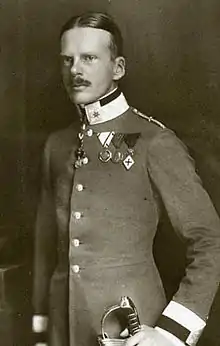Prince Georg of Bavaria
Prince Georg of Bavaria[1] (German: Georg Franz Joseph Luitpold Maria Prinz von Bayern; 2 April 1880 – 31 May 1943) was a member of the Bavarian Royal House of Wittelsbach and a Catholic priest.
| Prince Georg | |
|---|---|
 | |
| Born | 2 April 1880 Munich, Bavaria, German Empire |
| Died | 31 May 1943 (aged 63) Rome, Kingdom of Italy |
| Burial | |
| Spouse | |
| House | Wittelsbach |
| Father | Prince Leopold of Bavaria |
| Mother | Archduchess Gisela of Austria |
Birth and family
Georg was born in Munich, Bavaria, the elder son of Prince Leopold of Bavaria and his wife Archduchess Gisela of Austria. The New York Times described him as the favourite grandson of both the Emperor Franz Joseph I of Austria and the Prince Regent Luitpold of Bavaria.[2]
Military career
Georg entered the Bavarian army as a Second Lieutenant (German: Leutnant) a day before his 17th birthday on 1 April 1897; he was assigned to Infanterie-Leib-Regiment. On 8 February 1903, he was promoted to the rank of First Lieutenant (German: Oberleutnant) and then reassigned to the 1st Royal Bavarian Heavy Cavalry “Prince Charles of Bavaria”. Two years later, on 27 October 1905, he was promoted to Rittmeister, and on 26 October 1906 to Major. From 17 August 1908, he was also a Rittmeister and later Major in the 11th "Moravia" Austro-Hungarian Dragoons.[3] While in the army, he became a champion boxer.
Marriage
In December 1911, Georg became engaged to Archduchess Isabella of Austria (b. 17 November 1888 in Pressburg), daughter of Archduke Friedrich, Duke of Teschen, and his wife, Princess Isabella of Croy.[4] The wedding took place on 10 February 1912, in the Mariä Vermählung (Marriage of the Virgin Mary) Chapel in the Schönbrunn Palace in Vienna, officiated by Cardinal Franz Nagl.
The couple honeymooned in Wales, Paris, and Algiers,[5] but separated before the end of the honeymoon. There were several unsuccessful attempts at reconciliation. On 17 January 1913, the union was dissolved by the Royal Bavarian Supreme Court; on 5 March 1913, the union was annulled by the Holy See on the grounds of non-consummation.[6]
Isabella became a nurse in the Austrian army during World War I. During the war, she fell in love with the surgeon Paul Albrecht (1873–1928) and was briefly engaged to him until Emperor Franz Joseph I of Austria forbade the marriage.[7] She never married again, and died in La Tour-de-Peilz, Switzerland on 6 December 1973.
World War I
During World War I, Georg fought both on the Western Front (including the First Battle of Arras and the First Battle of Ypres) and on the Eastern Front. He started the war as commander of the Bavarian mechanized troops and eventually served under General Erich von Falkenhayn in Palestine. He was awarded both the I and II Class of the Iron Cross and on 14 December 1917 reached the rank of Colonel (German: Oberst).
Ecclesiastical career
In 1919, Georg resigned his military commission and began studying theology in Innsbruck, Austria. He was ordained a Catholic priest on 19 March 1921, and shortly afterwards received a doctorate in canon law from the Catholic Faculty of Theology at the University of Innsbruck.[8] He continued his religious studies in Rome and in 1925 graduated from the Pontifical Ecclesiastical Academy.[9]
On 18 November 1926, Pope Pius XI named Georg a domestic prelate with the title Monsignor.[10] In the 1930s, Georg was appointed a secular canon at St. Peter's Basilica in Rome. On 12 November 1941, Pope Pius XII named Georg a protonotary apostolic de numero participantium (one of the highest ranks of monsignor).[11]
Throughout his time in Rome, Georg lived at Villa San Francesco with the Franciscan Brothers of Waldbreitbach.[12] He maintained regular contact with his family, including his first cousin Crown Prince Rupprecht of Bavaria who moved to Rome in 1939. He was also in regular contact with other royal and princely houses; in 1930, he attended the Rome wedding of the Prince of Piedmont (later King Umberto II of Italy) to Princess Marie-José of Belgium,[13] and in 1935, he attended the Rome wedding of Infante Jaime of Spain.[14] In 1938, as grand prior of the Sacred Military Constantinian Order of Saint George he arranged the transfer of the remains of King Francis II of the Two Sicilies and of his wife Queen Maria Sophie from Schloss Tegernsee in Bavaria to the Chiesa del Santo Spirito in Rome.[15]
On 31 May 1943, Georg died at Villa San Francesco. One source says that he had been ill for some time.[16] Another source says that he died unexpectedly of tuberculosis contracted while working at a hospital.[17] He is buried in the Campo Santo Teutonico, the German cemetery immediately outside the walls of Vatican City.[18] In his will, he left money to pay for new bronze doors for St. Peter's Basilica;[19] these include the "Door of the Dead" by Giacomo Manzù and the "Door of the Sacraments" by Venanzo Crocetti.
Greek succession
A few writers (e.g. Martha Schad [20]) maintain that after the death of his father in 1930, Georg became the successor to the Greek rights of his great-uncle King Otto of Greece who was deposed in 1862. Georg's uncle Ludwig and his descendants were more senior, but Ludwig had renounced his Greek rights in 1869. However, the Greek Constitution of 1844 required that the successor of King Otto "shall profess the Greek Orthodox religion."[21]
Honours and awards
Prince Georg was President of the Royal Automobile Club of Bavaria (Königlich Bayerischer Automobil-Club).[22] In 1911 he became Protector of the Bavarian branch of the German Navy League.[23] In 1929 he became a member of the Archconfraternity of the Suffering Mother of God in the Campo Santo Teutonico.[12]
In 1933 a portrait bust of Georg was sculpted by Arno Breker.[24]
Orders and decorations[25]
.svg.png.webp) Kingdom of Bavaria:[26]
Kingdom of Bavaria:[26]

.svg.png.webp) Austria-Hungary:[27]
Austria-Hungary:[27]
- Knight of the Golden Fleece, 1900
- Grand Cross of the Royal Hungarian Order of St. Stephen, 1912
 Tuscan Grand Ducal Family: Grand Cross of St. Joseph, 1901
Tuscan Grand Ducal Family: Grand Cross of St. Joseph, 1901 Kingdom of Romania: Grand Cross of the Star of Romania, 1902
Kingdom of Romania: Grand Cross of the Star of Romania, 1902.svg.png.webp) Korean Empire: Grand Cordon of the Order of the Plum Blossoms, 1903
Korean Empire: Grand Cordon of the Order of the Plum Blossoms, 1903.svg.png.webp) Qing dynasty: Order of the Double Dragon, Class I Grade II, 1903
Qing dynasty: Order of the Double Dragon, Class I Grade II, 1903.svg.png.webp) Empire of Japan: Grand Cordon of the Order of the Chrysanthemum, 16 May 1905[28]
Empire of Japan: Grand Cordon of the Order of the Chrysanthemum, 16 May 1905[28].svg.png.webp) Kingdom of Portugal: Grand Cross of the Tower and Sword, 1906
Kingdom of Portugal: Grand Cross of the Tower and Sword, 1906.svg.png.webp) Siam: Knight of the Order of the Royal House of Chakri, 15 November 1906[29]
Siam: Knight of the Order of the Royal House of Chakri, 15 November 1906[29].svg.png.webp)
.svg.png.webp)
.svg.png.webp) Ernestine duchies: Grand Cross of the Saxe-Ernestine House Order, 1907
Ernestine duchies: Grand Cross of the Saxe-Ernestine House Order, 1907.svg.png.webp) Spain: Knight of the Military Order of Our Lady of Monteza, 1907
Spain: Knight of the Military Order of Our Lady of Monteza, 1907 Principality of Bulgaria: Grand Cross of St. Alexander, 1908
Principality of Bulgaria: Grand Cross of St. Alexander, 1908.svg.png.webp) Ottoman Empire: Grand Cordon of the Order of Glory, 1908
Ottoman Empire: Grand Cordon of the Order of Glory, 1908.svg.png.webp) Kingdom of Prussia:
Kingdom of Prussia:
- Knight of the Black Eagle, 1910[30]
- Cross of the Mount of Olives, 1910
- Iron Cross (1914), 2nd Class, 1914; 1st Class, 1915
.svg.png.webp) Two Sicilies: Bailiff Grand Cross of Justice of the Constantinian Order of St. George, with Collar
Two Sicilies: Bailiff Grand Cross of Justice of the Constantinian Order of St. George, with Collar United Kingdom: Honorary Grand Cross of the Royal Victorian Order, 21 August 1908[31]
United Kingdom: Honorary Grand Cross of the Royal Victorian Order, 21 August 1908[31]
Ancestry
Notes
- Regarding personal names: Prinz was a title before 1919, but now is regarded as part of the surname. It is translated as Prince. Before the August 1919 abolition of nobility as a legal class, titles preceded the full name when given (Graf Helmuth James von Moltke). Since 1919, these titles, along with any nobiliary prefix (von, zu, etc.), can be used, but are regarded as a dependent part of the surname, and thus come after any given names (Helmuth James Graf von Moltke). Titles and all dependent parts of surnames are ignored in alphabetical sorting. The feminine form is Prinzessin.
- "Mgr. Prince George of Bavaria Was 63", New York Times (June 2, 1943): 25.
- Almanach de Gotha: annuaire généalogique, diplomatique, et statistique 1910 (Gotha: Justus Perthes, 1910), 15.
- "Forthcoming Marriages", The Times (December 12, 1911): 11.
- Martha Schad, Kaiserin Elisabeth und ihre Töchter (München: Langen Müller, 1998), 37.
- Albrecht Weiland, Der Campo Santo Teutonico in Rom und Seine Grabdenmäler (Rome: Herder, 1988), 185.
- Radziwill, Princess Catherine. The Austrian Court From Within. London: 1916.
- Weiland, 185-186.
- Pontificia Accademia Ecclesiastica, Ex-alunni 1900–1949
- Acta Apostolicae Sedis 18 (1 decembris 1926): 510.
- Acta Apostolicae Sedis 33 (23 decembris 1941): 520.
- Weiland, 186.
- Luciano Regolo, La regina incompresa: tutto il racconto della vita di Maria José di Savoia (Milano: Simonelli, 1997), 414.
- Begoña Aranguren, Emanuela de Dampierre, Memorias: Esposa y madre de los Borbones que pudieron reinar en España (Madrid: Esfera, 2003), 105.
- Paolo Bardi, Roma Piemontese (1870-1876) (Rome: Bardi, 1970), 123.
- "La morte di Mons. Giorgio di Baviera", Osservatore Romano (2 giugno, 1943): 2.
- Schad, 37.
- Weiland, 185, which includes a description of his tombstone.
- Bill Pepper Curtis, An Artist and the Pope (New York: Madison Square Press, 1968), 120.
- Martha Schad, Kaiserin Elisabeth und ihre Töchter (München: Langen Müller, 1998)
- Charles A. Frazee, The Orthodox Church and Independent Greece, 1821-1852 (New York: Cambridge University Press, 1969): 162.
- Royal Automobile Club Year Book 1912 (London: Royal Automobile Club, 1912), 188.
- "German Navy League", The Times (May 4, 1911): 5.
- Dominique Egret, Arno Breker: Ein Leben für das Schöne (Tübingen: Grabert, 1996), no. 82.
- Decorations as of 1914 from the Bavarian War Ministry, Militär-Handbuch des Königreichs Bayern, 1914. World War I decorations from award rolls, Erhard Roth, Verleihungen von militärischen Orden und Ehrenzeichen des Königreichs Bayern im Ersten Weltkrieg, 1997 (ISBN 3-932543-19-X), and Ferry W. von Péter, Verleihungen nichtbayerischer Orden und Ehrenzeichen an bayerischer Militärangehörige 1914-1918, 2001 (OCLC 163144588)
- Hof- und Staats-Handbuch des Königreich Bayern (1908), "Königliche Orden" pp. 7, 11
- "Ritter-Orden", Hof- und Staatshandbuch der Österreichisch-Ungarischen Monarchie, 1918, pp. 50, 56, retrieved 20 July 2020
- 刑部芳則 (2017). 明治時代の勲章外交儀礼 (PDF) (in Japanese). 明治聖徳記念学会紀要. p. 150.
- Royal Thai Government Gazette (25 November 1906). "พระราชทานเครื่องราชอิสริยาภรณ์" (PDF) (in Thai). Archived from the original (PDF) on May 8, 2019. Retrieved 2019-05-08.
{{cite journal}}: Cite journal requires|journal=(help) - Almanach de Gotha 1910, 15.
- The London Gazette, issue 28170, p. 6145
Bibliography
- Marriage. Wiener Zeitung, February 11, 1912, p. 1.
- "The Austro-Bavarian Marriage", The Times, February 10, 1912, p. 5.
- "The Austro-Bavarian Marriage", The Times, February 12, 1912, p. 5.
- "Prince and Bride Part", New York Times, September 20, 1912, p. 4.
- "Prince's Marriage Voided", New York Times, October 7, 1912, p. 1.
- "Won't Annul Marriage", New York Times, October 12, 1912, p. 4.
- "Princess Seeks Divorce", New York Times, November 5, 1912, p. 8.
- "Royal Marriage Has Been Dissolved", New York Times, January 18, 1913, p. 3.
- "Prince George of Bavaria", The Times, January 18, 1913, p. 5.
- "Dissolution of a Royal Marriage", The Times, April 28, 1913, p. 5.
- "Mgr. Prince George of Bavaria Was 63". New York Times, June 2, 1943, p. 25.
- Schad, Martha. Kaiserin Elisabeth und ihre Töchter. München: Langen Müller, 1998.